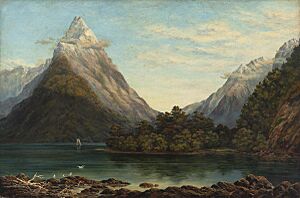Mitre Peak (New Zealand) facts for kids
Quick facts for kids Mitre Peak |
|
|---|---|

Mitre Peak, Milford Sound
|
|
| Highest point | |
| Elevation | 1,683 m (5,522 ft) |
| Parent peak | Aoraki / Mount Cook |
| Geography | |
Mitre Peak (in Māori, Rahotu) is a famous mountain in the South Island of New Zealand. It stands tall right on the edge of Milford Sound, a beautiful fiord. This mountain is well-known for its unique shape and stunning views.
Contents
Why is it called Mitre Peak?
The mountain got its name from Captain John Lort Stokes. He was exploring the area in his ship, HMS Acheron. Captain Stokes thought the mountain looked like a special hat. This hat is called a mitre. Christian bishops wear mitres. The Māori name for this peak is Rahotu.
Where is Mitre Peak?
Mitre Peak is located very close to the water in Milford Sound. This area is part of the Fiordland National Park. The park is in the southwestern part of New Zealand's South Island. The mountain rises very steeply from the water. It reaches a height of 1,683 meters (about 5,560 feet).
Even though it looks like one sharp peak, Mitre Peak is actually a group of five peaks very close together. From most places you can see it, it appears as a single point. Milford Sound, where the peak is, is part of Te Wahipounamu. This whole area is a World Heritage Site. It was given this special title by UNESCO. The amazing scenery around Mitre Peak makes it a favorite subject for artists. You can see a painting of it by Charles Decimus Barraud at the Sarjeant Gallery in Whanganui.
The only road that leads to Milford Sound is State Highway 94.
Climbing Mitre Peak
Climbing Mitre Peak is very challenging. Because it's so hard to reach, not many people try to climb it.
Early Attempts to Climb
The first known attempt to climb the peak was in 1883. An artist from Invercargill, Samuel Mereton, tried with Donald Sutherland. They took a boat to Sinbad Bay. On February 6, they set up camp at the end of the valley. The next day, they climbed towards the top. They had very little gear, no warm coats, and only one biscuit each! They reached the top of the Mitre Range. From there, they could see Mitre Peak about 3 kilometers away. It was too late to keep climbing down. So, they had to sleep right where they were overnight. The next day, a storm was coming. They decided to stop their climb to stay safe. They had a tough climb back down. They waited two more days in bad weather. Finally, they rowed back across Milford Sound to a hotel.
The First Successful Climb
In 1911, a climber named Jim Dennistoun walked to Milford Sound. He came from Lake Te Anau over McKinnon Pass. He wanted to find someone to climb Mitre Peak with him. None of the local porters had climbing experience. But one porter, Joe Beaglehole, had read a famous climbing book. Dennistoun chose Joe to go with him.
Dennistoun had seen a possible climbing path in 1909. But he decided to use a route that Donald Sutherland had suggested. On March 13, 1911, they started climbing at 7:30 AM. They rowed a boat to Sinbad Gully, at the base of the peak. They climbed through the forest. When they were about 300 meters from the top, Joe Beaglehole found it too hard to continue. He stopped. Dennistoun kept going alone. He climbed up steep, smooth rock slabs. He reached the very top at 1:15 PM.
Dennistoun then climbed back down. He met Joe Beaglehole. To avoid climbing back over a difficult spot, they decided to go straight down into Sinbad Gully. This meant they had to use a rope to lower themselves down steep cliffs. They reached the valley floor when it was dark. It also started to rain. They had no camping gear. So, they had to keep going until they reached their boat at 9:45 PM. Then, they rowed back across to the hotel to sleep.
Proof of the Climb
Donald Sutherland had said that Mitre Peak could not be climbed. So, he didn't believe Dennistoun had reached the top. But in 1914, two other climbers, Jack Murrell and Edger Williams, found Dennistoun's handkerchief. It was in a small pile of rocks at the very top of the peak. This proved that Dennistoun had made it! When J.H. Christie and G. Raymond made the third climb in 1941, they found parts of the handkerchief. They also found two old coins left by Murrell and Williams.
Climbing Paths Today
There are six different ways to climb up Mitre Peak. Most climbers start by taking a boat to Sinbad Bay.



